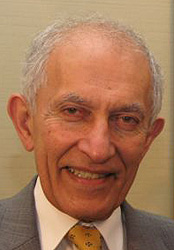
View Professor David de Kretser's photo gallery
You can order the DVD from the Academy for $15 (including GST and postage)
Professor David de Kretser was interviewed in 2008 for the Interviews with Australian scientists series. By viewing the interviews in this series, or reading the transcripts and extracts, your students can begin to appreciate Australia's contribution to the growth of scientific knowledge.
The following summary of de Kretser's career sets the context for the extract chosen for these teachers notes. The extract discusses how he and his colleagues came to isolate and characterise the reproductive hormone, inhibin. Use the focus questions that accompany the extract to promote discussion among your students.
David de Kretser was born in Colombo, Sri Lanka (then known as Ceylon), in 1939. He moved to Melbourne with his family when he was aged nine. While he enjoyed science and maths in school, his interest in biology convinced him to study medicine. He received an MBBS from the University of Melbourne in1962. His clinical training and residency were at Prince Henry’s Hospital.
In 1965 he began working at Monash University in the department of anatomy. He was a demonstrator (1965), lecturer (1966–1968) and then senior lecturer (1968). During these years, de Kretser became interested in endocrinology. He received a Doctor of Medicine from Monash University in 1969 for research into the structure and function of the human testes. After his MD, de Kretser took a leave of absence from Monash University and worked as a senior fellow of endocrinology at the University of Washington (Seattle) from 1969 to 1971.
On returning to Australia and Monash University in 1971, de Kretser took up an appointment that combined medicine (at Prince Henry’s Hospital) and anatomy. This combination is characteristic of his career, which has been focused on trying to relate structure-function relationships. He was professor of anatomy at the Faculty of Medicine, Nursing and Health Sciences from 1978 to 2005 and served as the faculty’s associate dean for biotechnology development from 2002 to 2006.
De Kretser was also founding director of the Monash Institute of Reproduction and Development (now known as the Monash Institute of Medical Research), serving from 1991 to 2005. In 2000, he founded Andrology Australia, which aims to better educate consumers and health professionals about male reproductive health disorders.
De Kretser has received numerous international awards including the Robert H Williams Distinguished Leadership Award (USA Endocrine Society, 2004) and the Distinguished Andrologist Award (American Society of Andrology, 2003). He was made an Officer of the Order of Australia in 2000 and Companion of the Order of Australia in 2006. He received the Australia Centenary Medal in 2003. In 2006 he was appointed Governor of Victoria for a five-year term.
De Kretser was elected a Fellow of the Australian Academy of Science in 1996.
David, the Inhibin accomplishment has been a major one for you and your colleagues. Would you take us over that story in a bit more detail, for lay people to get some appreciation of the hurdles you faced?
Well, in 1932 it had been postulated that, in addition to a steroid hormone which was ultimately purified as testosterone, the testis made something which was not a steroid but which actually suppressed the function of the pituitary. In those days they couldn’t measure gonadotrophin secretion. They were looking at castration cells in the pituitary. That was the bioassay that they used – a very laborious bioassay.
But with the advent of radioimmunoassays we were able to measure the hormones and look at what damage to the testis would do to feedback in terms of follicle stimulating hormone (FSH) secretion. And so we put together a collection of animal model data which said, really, that there had to be something other than testosterone controlling FSH secretion. That was critical in providing the fundamental base which set us off, trying to find Inhibin.
You know, it was a team effort. It involved Henry Burger; it involved Bryan Hudson for a while, until Bryan went to the Florey and left Prince Henry’s. And to some extent we then had a little bit of Australian competition between the Florey group, which had Hugh Niall there, and Henry and myself, and Frank Morgan, who was at St Vincent’s. There was also some competition from other places, which we didn’t actually know much about – it was kept very quiet. So it was a fascinating journey.
But one of the biggest issues was to work out a bioassay such that you could screen large numbers of fractions off columns, which was essential in the purification. Really, it was a graduate student working with us who developed pituitary cells in culture and was able then to measure FSH secretion and show that there were extracts in the testis, initially, which actually suppressed FSH secretion by those pituitary cells.
In the end, though, we purified Inhibin from follicular fluid in the ovary. We used to go down to the abattoirs and collect ovaries, bring them back and suck the fluid out from each follicle. We would put that together, and once you got a litre or so of it you had your starting material.
Does that suggest there’s not much species specificity to Inhibin?
There isn’t, we’ve subsequently found out, in that Inhibin turned out to be a dimer of an alpha and a beta subunit. In fact, there are two Inhibins: the alpha subunits are the same and the beta subunits are different. But it is all related. The beta subunit is conserved 100 per cent in its protein structure from the mouse to the human, and the only variation is one amino acid in the sheep. So it’s a highly conserved molecule.
Select activities that are most appropriate for your lesson plan or add your own. You can also encourage students to identify key issues in the preceding extract and devise their own questions or topics for discussion.
© 2025 Australian Academy of Science